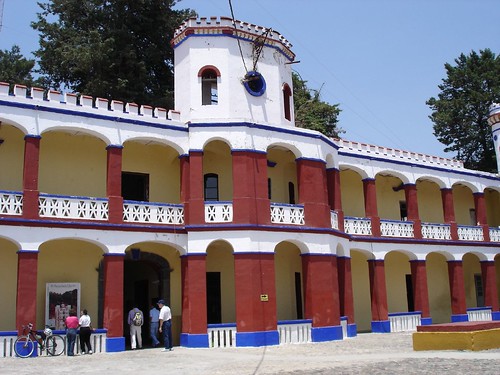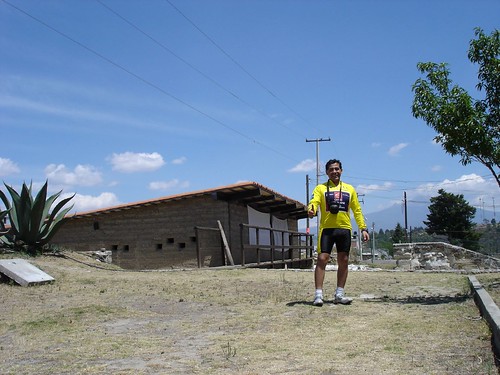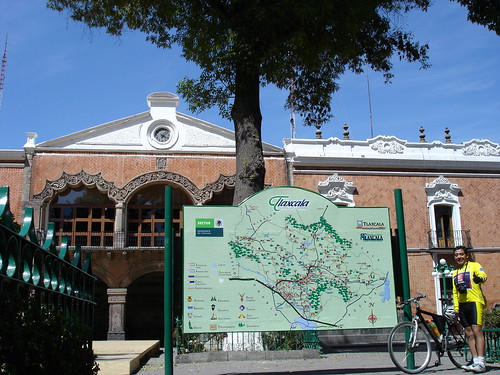Chiautla Ex-Hacienda (Puebla), 15.04.07
Map Navigation: This dynamic Trackmap shows the GPS track (red line) and some geo-referenced photos (red dots) of the cycling tour. Wheel up and wheel down your mouse to zoom in or zoom out the map. Click on any point in the map to center it on that point. Or just drag the map with your mouse. To see the photos, hoover the mouse over the red dots. Click on the photo to go to the picture page.

Photoset Map
Photoset Show
GPS Track: GPX (MapSource, et al), or KMZ (Google Earth)

Photoset Map
Photoset Show
GPS Track: GPX (MapSource, et al), or KMZ (Google Earth)
GPS Cycling Data:



Distance: 180 Km, Total Ascent: 2050 m, Total Descent: 2050 m, Cycling Time: 7:55 hr, Avg. Speed: 22.6 Km/hr, Max Speed: 65.2 Km/hr, Energy Expended: 35.43 MJ, Cycling Power: 311 W.
Travel Report:
This ride started at 09:15 hr, a little late, but without consequences, as last week :-) This ride took me to the interesting Chiautla Ex-Hacienda, a beautiful XIX century pulque Hacienda, which with its symmetrical gardens and artificial lake (a dam, in fact) clearly resembles the Versailles palace. The Chiautla Hacienda is located 4 km before Sn Martin Texmelucan, in the eastern state of Puebla.
In order to arrive at Chiautla (Puebla) from Mexico City center (elev: 2240 m), I took Fray Servando and later Zaragoza Av. In the messy junction where the free and pay Puebla highways diverge, I could lastly take the right path, riding the free highway from its very beginning, something I was previously unable to make, due to the gigantic traffic jam that the junction is nowadays converted in.
Entering in Ixtapaluca, I ride all that avenue that crosses this big county. Ixtapaluca stretches up to Rio Frio, on the Puebla border. The road is mainly plain up to the town of Zoquiapan, where the road starts to elevate at a grade of more than 5 %. As usual, the landscapes along the route were stunning, albeit with a little more smog owed to the later hour.
At Avila Camacho (elev: 2900 m) I stopped as I was already starving, buying there some fruit. In Ávila Camacho I could observe several cycling groups that use to rest or eat in town, before continuing their climbing to the Llano Grande summit. Once I re-assumed the ascent, I reached Llano Grande (elev: 3210 m), and paid a visit to the lonely blue guadalupean church that crowns that location, a humble and small church where a group of cyclists from Chimalhuacán were resting from the hard climbing and sunny weather. After we exchanged some words, we departed, as they returned to Mexico City, and I continued to the other side of the summit, in Texmelucan direction.
After Rio Frio I found a cycling race on the highway. After having a look at the photos I took of some of those racers, I believe they were riding one-speed bikes. A hard way to climb the highway towards Llano Grande, if you mind.
I continued my descent, crossing Sta Rita, Sn Matias, and Sn Lucas. The road to the Chiautla Ex-Hacienda is located after the town of Sn Lucas (elev: ca 2300 m), to the left. There is a big sign there, so you can not miss the entrance. After almost 2 km of dirt road, I finally arrived at the gates of the Hacienda.
But alas ! I found myself confronted with two big problems there:
Once in the highway, I decided (in order to avoid last week hellish nocturnal no-lights 1000 m descent from Llano Grande to Mexico City) not going to Texmelucan, to finish the first leg of my journey, although it was distant only 4 km from that location. Instead, I decided to immediately return to Mexico City, so I could arrive at Llano Grande with light :-)
Starting now the second climbing to the summit, I stopped at Sta Rita (elev: 2600 m), last town before the Zoquiapan National Park, for buying water. From Sta Rita there are no towns until Rio Frio (elev: 3000 m), which I passed by, reaching again the Llano Grande summit at 17:10 :-)
Continuing the descent with no further delays, I rode along the free highway, this time in Mexico City direction, arriving at the bottom of it in Ixtapaluca (elev: 2300), at 17:54. From here its rested only a 32 km long plain ride back home, finally arriving at the center of Mexico City at 19:17, fully under the cover of the light :-)
Thank you for reading. Till the next travel.



Distance: 180 Km, Total Ascent: 2050 m, Total Descent: 2050 m, Cycling Time: 7:55 hr, Avg. Speed: 22.6 Km/hr, Max Speed: 65.2 Km/hr, Energy Expended: 35.43 MJ, Cycling Power: 311 W.
Travel Report:
This ride started at 09:15 hr, a little late, but without consequences, as last week :-) This ride took me to the interesting Chiautla Ex-Hacienda, a beautiful XIX century pulque Hacienda, which with its symmetrical gardens and artificial lake (a dam, in fact) clearly resembles the Versailles palace. The Chiautla Hacienda is located 4 km before Sn Martin Texmelucan, in the eastern state of Puebla.
In order to arrive at Chiautla (Puebla) from Mexico City center (elev: 2240 m), I took Fray Servando and later Zaragoza Av. In the messy junction where the free and pay Puebla highways diverge, I could lastly take the right path, riding the free highway from its very beginning, something I was previously unable to make, due to the gigantic traffic jam that the junction is nowadays converted in.
Entering in Ixtapaluca, I ride all that avenue that crosses this big county. Ixtapaluca stretches up to Rio Frio, on the Puebla border. The road is mainly plain up to the town of Zoquiapan, where the road starts to elevate at a grade of more than 5 %. As usual, the landscapes along the route were stunning, albeit with a little more smog owed to the later hour.
At Avila Camacho (elev: 2900 m) I stopped as I was already starving, buying there some fruit. In Ávila Camacho I could observe several cycling groups that use to rest or eat in town, before continuing their climbing to the Llano Grande summit. Once I re-assumed the ascent, I reached Llano Grande (elev: 3210 m), and paid a visit to the lonely blue guadalupean church that crowns that location, a humble and small church where a group of cyclists from Chimalhuacán were resting from the hard climbing and sunny weather. After we exchanged some words, we departed, as they returned to Mexico City, and I continued to the other side of the summit, in Texmelucan direction.
After Rio Frio I found a cycling race on the highway. After having a look at the photos I took of some of those racers, I believe they were riding one-speed bikes. A hard way to climb the highway towards Llano Grande, if you mind.
I continued my descent, crossing Sta Rita, Sn Matias, and Sn Lucas. The road to the Chiautla Ex-Hacienda is located after the town of Sn Lucas (elev: ca 2300 m), to the left. There is a big sign there, so you can not miss the entrance. After almost 2 km of dirt road, I finally arrived at the gates of the Hacienda.
But alas ! I found myself confronted with two big problems there:
- I could not enter with the bike, so I had to walk, and I had only my carbon-fiber SPD cycling shoes, not really a pleasure to walk with, and
- I had to pay an entrance fee ! Any Mexican can visit the biggest national archaeological sites and museums free of charge on Sundays, and there, I had to pay 40 pesos to have a look at some small porfirist pulque Hacienda ! Unbelievable but true :-(
Once in the highway, I decided (in order to avoid last week hellish nocturnal no-lights 1000 m descent from Llano Grande to Mexico City) not going to Texmelucan, to finish the first leg of my journey, although it was distant only 4 km from that location. Instead, I decided to immediately return to Mexico City, so I could arrive at Llano Grande with light :-)
Starting now the second climbing to the summit, I stopped at Sta Rita (elev: 2600 m), last town before the Zoquiapan National Park, for buying water. From Sta Rita there are no towns until Rio Frio (elev: 3000 m), which I passed by, reaching again the Llano Grande summit at 17:10 :-)
Continuing the descent with no further delays, I rode along the free highway, this time in Mexico City direction, arriving at the bottom of it in Ixtapaluca (elev: 2300), at 17:54. From here its rested only a 32 km long plain ride back home, finally arriving at the center of Mexico City at 19:17, fully under the cover of the light :-)
Thank you for reading. Till the next travel.





